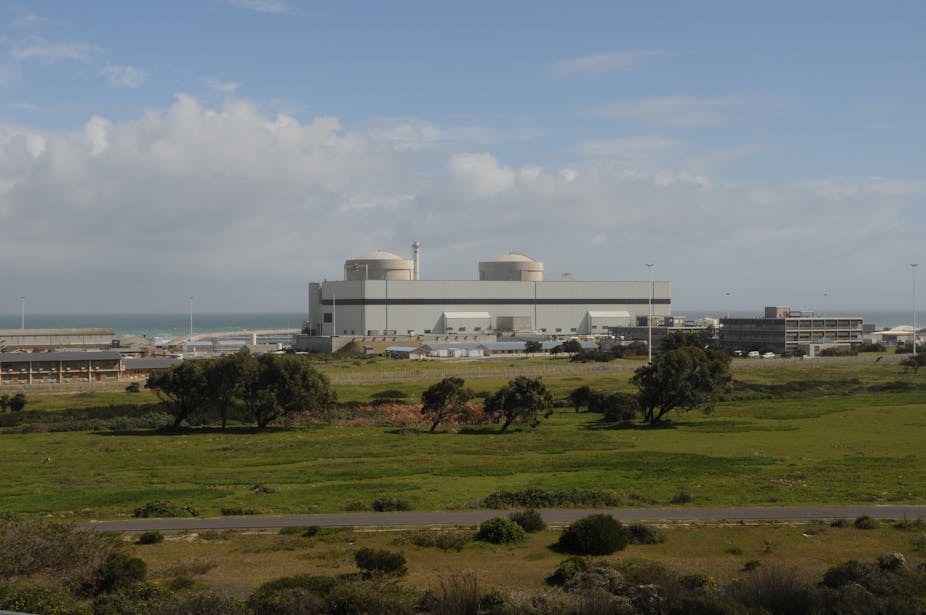Africa’s only operational nuclear power plant is in an area called Koeberg, outside Cape Town in South Africa. The life span of the plant was originally meant to end in 2024. But after an upgrade it’s now expected to operate until around 2044.
In theory it could be shut down, or decommissioned, earlier than if, for example, there was a spike in anti-nuclear sentiment, it becomes unprofitable or a serious technical failure developed.
Koeberg has two units, each generating 930 MW, which contribute about 4% of South Africa’s power capacity. They were built by French developer Framatome, now called Areva.
The funding for decommissioning, which is an expensive process, needs to be secured well in advance. Failing to decommission the site properly would saddle Cape Town with a dangerous radiation hazard for generations to come.
Responsibility for Koeberg’s site rehabilitation rests with its operator, the state electricity utility, Eskom. For now decommissioning Koeberg is not a priority for Eskom’s newly appointed board given its need to deal with the financial pressure and allegations of corruption the utility is facing.
But it will nevertheless need to start planning soon.
The decommissioning process
There are three stages in the rehabilitation of a nuclear facility.
The plant must be dismantled. This is complicated because most of the material in and around the plant is radioactive to varying degrees and therefore dangerous to anything exposed to it. Radioactivity reduces with time, but for some isotopes commonly found in nuclear waste, the drop in radiation levels can be very slow. Because of this a plant will only be dismantled years after it’s been switched off.
The dangerous nuclear waste, or high level waste must be reprocessed. Most of the material stays dangerous for decades but some isotopes retain high levels of radiation levels for thousands of years. A portion of nuclear waste can be converted into reusable or less radioactive forms through nuclear engineering processes. These processes are complex and there are only a few facilities in the world that can perform them. This means that South Africa’s high level waste will have to be transported overseas. Reprocessing facilities include La Hague in France and the Russian Mayak site, thought to be responsible for the 2017 ruthenium leak incident.
The remaining nuclear waste must be secured in storage, virtually forever. This needs an isolated site that can’t be damaged by natural disasters or other processes that could cause radioactive material to seep into the surrounding environment, especially ground water. This final storage need is a massive headache worldwide. An example is the German Gorleben final repository site. It’s been the scene of protests for decades, preventing any further storage of waste on the site.
There are a handful of cases where the first two stages have been completed, typically over periods of ten years. But completing the final storage phase of nuclear waste hasn’t been achieved for any former plants. Their most hazardous waste is still in temporary storage, sometimes even on site.
Decommissioning Koeberg
The complexity, time frame and cost of decommissioning can differ greatly. A minor research reactor is far easier to deal with than a disaster site like Japan’s Fukushima, where the cleanup is now estimated to cost around USD$180 billion.
The Koeberg decommissioning scenario should rather be based on plants of similar age and size in the process of closure in Europe and North America.
Researchers in France, Germany and the UK have calculated widely different costs for nuclear cleanups (including waste disposal) in their countries. The potential cost of decommissioning a site comparable to Koeberg according to the French costing model would be R8.4 billion. Some analysts say this is unrealistically low. The German model puts the number at around R39 billion and the UK model at R76 billion.
Models based on estimates for Belgium and Canada translate to a Koeberg decommissioning cost of R48 billion and R50 billion respectively, while a recent local determination puts the figure at R35 billion.
All nuclear power plants accredited by the International Atomic Energy Agency must regularly set aside funds to finance the eventual decommissioning. By 2016, Eskom had paid R10.9 billion into a trust for this purpose.
But these provisions seem insufficient and the utility will probably need to raise additional funding to shut down Koeberg.
Eskom is responsible to pay for the site’s rehabilitation, but not for final waste disposal. The funding of that process ultimately becomes the responsibility of the state.
Waste from Koeberg
The arrangement is that low and intermediate-level nuclear waste is transported to a site called Vaalputs in sparsely populated Namakwaland, about 500 km north of Cape Town. High-level waste is kept on site in Koeberg in what are known as fuel pools.
South Africa doesn’t have storage facilities for its high-level waste. Like the rest of the world, construction of nuclear plants was initiated without a specific waste disposal plan, with the understanding that each country would manage and pay for it themselves.
Unfortunately South Africa is likely to approach decommissioning Koeberg in the same way other countries have done it – by effectively leaving the waste on site indefinitely in temporary storage facilities. This avoids the expense of waste processing as well as making difficult political decisions. But it passes the problem to future generations while continuing to expose the nuclear plant’s neighbourhood to contamination risk. This is a serious risk at Koeberg given that it’s a mere 30 km from the Cape Town city centre.
Koeberg’s decommissioning is an awkward reality that cannot be ignored for much longer. This should become the main focus for nuclear professionals in South Africa, rather than new plants. Eskom and other parties in the energy space need to develop detailed, credible decommissioning work plans with realistic costing scenarios and funding strategies. A crisis can be avoided, but only through early and proper planning.

